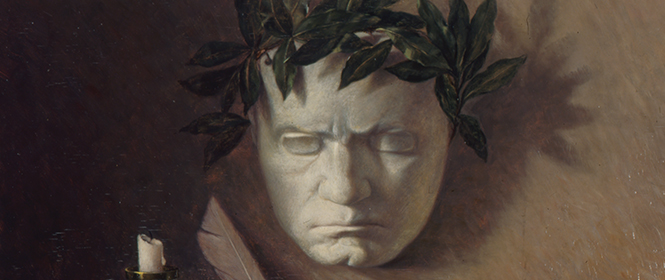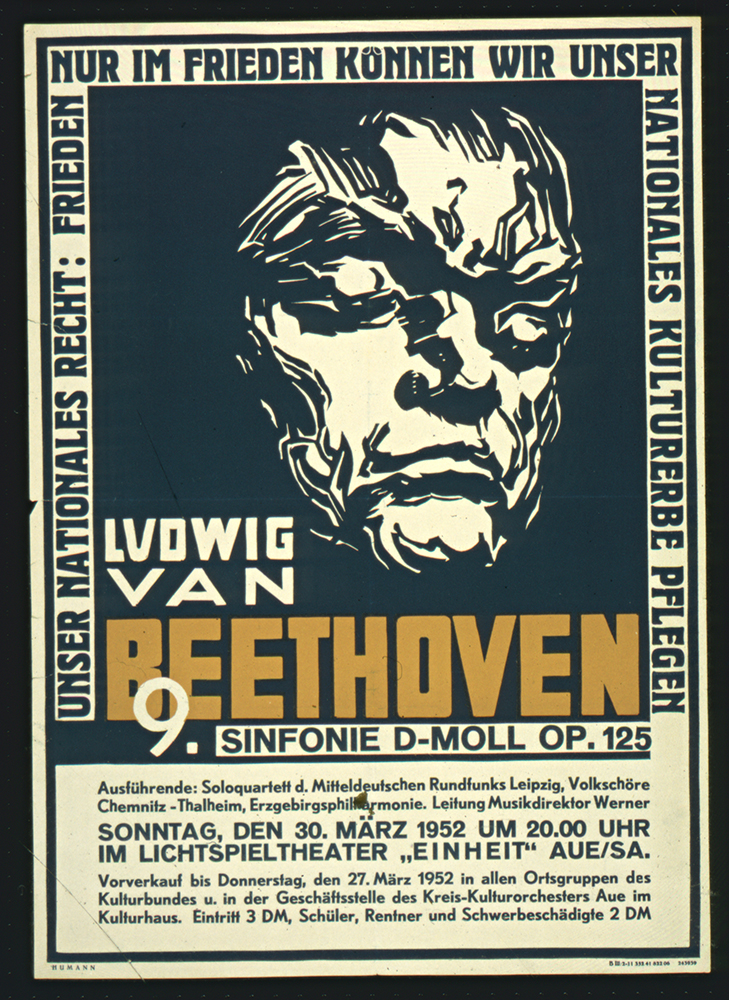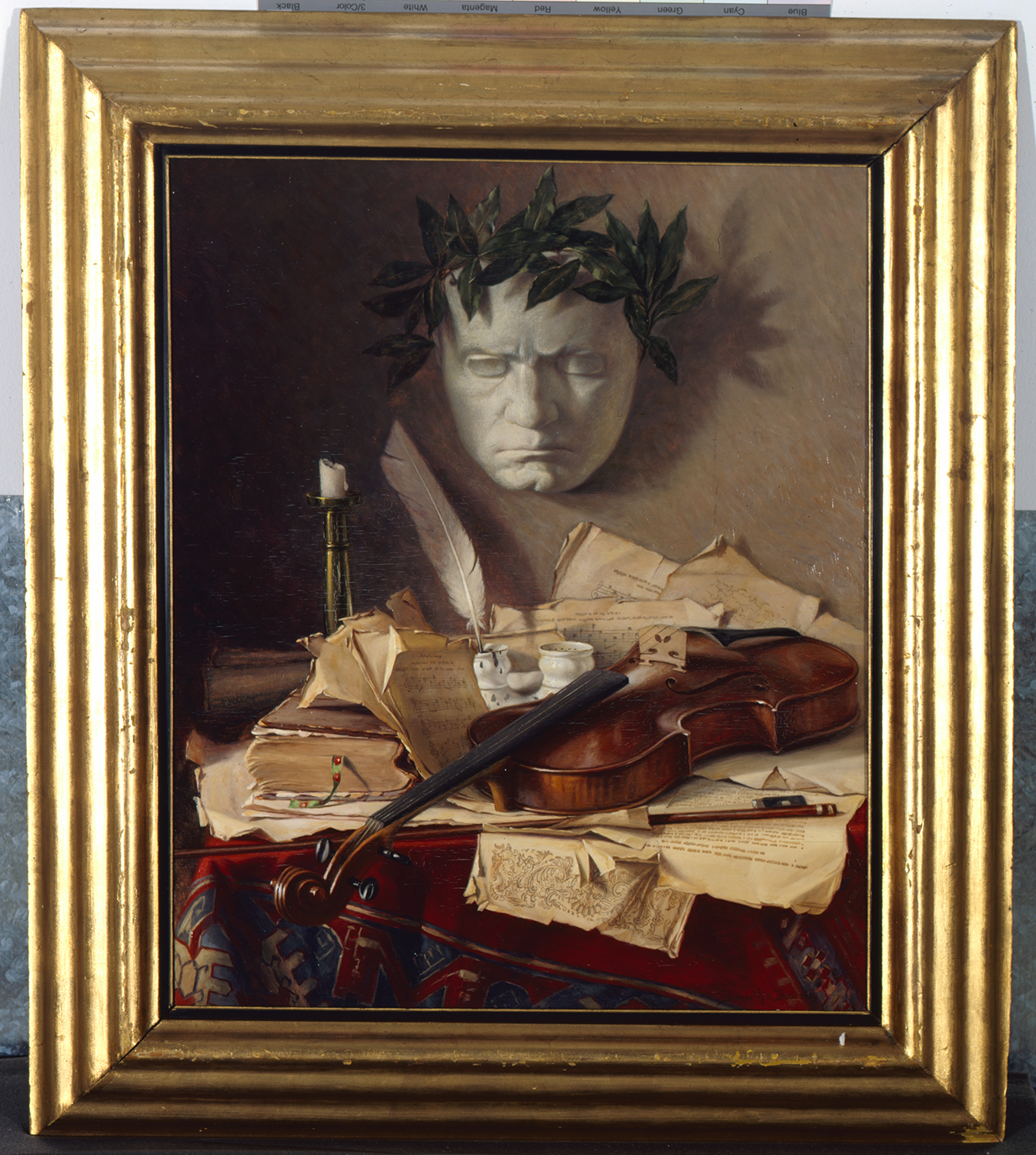
Beethoven’s Music Gone Astray
Christian Kämpf | 17 December 2020
“Musical Titan”, “Freedom Fighter”, “Hero” – to this very day Ludwig van Beethoven’s admirers and critics feel the urge to co-opt his life and music. Christian Kämpf, curator of the thematic path “Beethoven | Freedom” in the DHM’s Permanent Exhibition, traces the political instrumentalization of Beethoven and takes a close look at two special moments in German history.
The popular image of Beethoven today is largely based on two aspects: on the one side, the limitation Beethoven was faced with because of his hearing ailment; on the other, the liberties he nevertheless took in art and society. Beethoven is seen as a “political composer”, a “revolutionary genius”, sometimes even as a “hero” and “freedom fighter”. This Beethoven image has always provided a perspective for interpreting the composer’s life and work – even during his lifetime.
Problematical is the fact that this narrow view of Beethoven has fostered, and even provoked, the political instrumentalization of his life and work at different times and in different systems. The connection of the terms “Beethoven” and “freedom” was exploited in the war propaganda of the German Empire, but equally so by antifeudal forces in the Vormärz period, and later by the National Socialists and the socialist regime of the GDR.
Beethoven, freedom, peace
The perception of Beethoven’s music as “freedom music” not only conjures up the topoi of battle and victory, but dialectically always also evokes the notion of peace. When Beethoven’s musical battle painting Wellington’s Victory was performed at the beginning of the Congress of Vienna in 1814, contemporaries were reminded not only of the war against Napoleonic France and the triumphal victories of the alliance. At the same time, the audience celebrated the peace that had been achieved as a prerequisite for a coexistence of the European peoples in unity and freedom, which the roughly 200 diplomats had come to Vienna to secure through their difficult negotiations.
As mirrored in its reception, it is above all Beethoven’s Ninth Symphony that stands out as a work with which idealistic images of battle and victory, of peace and liberty, can be evoked and interwoven with one another for all kinds of occasions. In the following, we will look at two examples of this kind of co-opting: the performance of the Ninth in 1952 in the city of Aue in the Erzgebirge within the framework of the Tribute to Beethoven in the GDR, and the partial performance of that work in 1936 within the framework of the opening of the 11th Olympic Summer Games in Berlin.
Beethoven in the German Democratic Republic
On 26 March 1952, on the occasion of the 125th anniversary of the death of Beethoven, a centrally organised Festival Week was celebrated throughout East Germany, with performances of important works even in the smaller cities. The programme was often carried out by lay orchestras and choruses as part of the so-called German Tribute to Beethoven, as in our example from Aue in the Erzgebirge.

Announcement poster for the performance of Ludwig van Beethoven’s 9th Symphony in D minor Opus 125 at the “Einheit” cinema in Aue/Saale on the occasion of Beethoven’s 125th death anniversary on 26 March 1952, Helmut Humann, GDR 1952 © DHM
The central idea behind the concert was formulated on the poster announcing the performance: “Our national right: peace. Only in peace can we cultivate our national heritage.” For the government, of course, the sole guarantee for peace was socialism in its resistance to Western imperialism. That was the state doctrine of the GDR. The East German government therefore claimed for itself the prerogative to interpret the life and work of Beethoven and the proper cultivation of his music as their national heritage. The commitment to Beethoven, said Wilhelm Pieck, then President of the GDR, was at the same time a commitment to peace. It was in this sense that the GDR leadership, only a few years after the war, interpreted the Ninth Symphony with Schiller’s Ode to Joy and the verse “Be embraced, Millions!” as music representing socialist harmony and used it as a didactical means to instruct the citizens of the young GDR state in the spirit of peace and international friendship, not without pinpointing the enemies of peace clearly in the West.
The festivities of the Beethoven tribute in 1952 were a dry run, so to speak, for the even greater jubilee in the following year. In 1953, namely, it was time to celebrated Karl Marx on the occasion of his 135th birthday and the 70th anniversary of his death. To be sure, Beethoven’s “peace music” could not be missing from this celebration. It was heard time and again at the various ceremonial acts for Marx throughout the land, for example, during the ceremony of the SED district administration in Erfurt on 3 May 1953. The Ninth was featured together with the prisoners’ chorus from Fidelio, the Internationale, and the song Stalin, Friend, Stalin, in which the personality cult of Joseph Stalin manifested itself and which extolled him as the great benefactor of peace and freedom.
Beethoven under the Nazi regime
At the opening of the Olympic Games in Berlin on 1 August 1936, the themes of battle and victory, freedom and peace, were also heard in the musical programme accompanying the sporting events. The opening ceremony culminated in the performance of the fourth movement of Beethoven’s Ninth Symphony. This final accent was the wish of Pierre de Coubertin, who had revived the Olympic Games forty years earlier and founded the IOC. But here again, Beethoven’s music did not resound alone in isolation. The musical programme planned by the National Socialist Organisation Committee placed the Ninth Symphony alongside Richard Wagner’s March in Homage to Ludwig II of Bavaria, Händel’s Hallelujah Chorus, Prussian military marches, the Deutschlandlied, and the Horst Wessel Song, as well as more recent compositions by the “divinely gifted” Richard Strauss, Carl Orff and Werner Egk. And finally, the Ode to Joy was mixed in together with the dance festival piece Olympic Youth, which featured such songs as “Peace, Joy, Festival of Youth” and the “Struggle for Honour, Fatherland”.
While Coubertin wanted to emphasise the Olympic ideals of peace and international solidarity by performing the Ode to Joy, the Nazi organisers used the musical context of “Be embraced, Millions!” to refer exclusively to their own movement and the German “community of the people”. Under this banner, the Ninth Symphony later embellished the festive concerts celebrating Hitler’s birthday.

Still live with a mask of Beethoven, Josef Jurutka, Painting, Deutsches Reich 1937 © DHM
Hitler’s image of Beethoven no doubt corresponded almost exactly with Josef Jurutka’s still-life painting Beethoven from 1937. Hovering above an extinguished candle, a quill, yellowed music paper and a string instrument is the laurel-wreathed life mask of the composer. After completing his work, Beethoven seems to triumph as the ingenious creator, having earned the victory crown against all earthly resistance as a strong-willed, conscientious man of action, released from all finiteness through his own deeds. Hitler could identify with that. In 1939 he purchased the painting for his own private collection.
Often enough, it is precisely this familiar “Beethoven and freedom” pattern of reception that has stood behind the commitments to peace that are supposedly conveyed through Beethoven’s music, particularly in the Ninth Symphony. In this pattern, certain aspects of freedom and peace are interlaced with notions of battle and victory and are thus connected with distinctive images of concrete enemies and opponents. A consciousness of such misconceptions in the composer’s reception can safeguard against perpetuating the melodramatic and unbroken narrative of Beethoven as an icon of freedom, particularly with respect to the Ode to Joy, which today, as the national anthem of Europe, is meant to stand for the European values of equality, solidarity, freedom and peace.